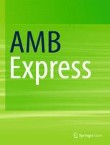References
Examples of the Basic Springer reference style are shown below.
See our editorial policies for author guidance on good citation practice.
Web links and URLs: All web links and URLs, including links to the authors' own websites, should be given a reference number and included in the reference list rather than within the text of the manuscript. They should be provided in full, including both the title of the site and the URL, as well as the date the site was accessed, in the following format: The Mouse Tumor Biology Database. http://tumor.informatics.jax.org/mtbwi/index.do. Accessed 20 May 2013. If an author or group of authors can clearly be associated with a web link, such as for weblogs, then they should be included in the reference.
Example reference style:
Article within a journal
Smith J, Jones M Jr, Houghton L (1999) Future of health insurance. N Engl J Med 965:325-329.
Article by DOI (with page numbers)
Slifka MK, Whitton JL (2000) Clinical implications of dysregulated cytokine production. J Mol Med 78:74-80. doi:10.1007/s001090000086.
Article by DOI (before issue publication and with page numbers)
Slifka MK, Whitton JL (2000) Clinical implications of dysregulated cytokine production. J Mol Med. doi:10.1007/s001090000086.
Article in electronic journal by DOI (no paginated version)
Slifka MK, Whitton JL (2000) Clinical implications of dysregulated cytokine production. Dig J Mol Med. doi:10.1007/s801090000086.
Journal issue with issue editor
Smith J (ed) (1998) Rodent genes. Mod Genomics J 14(6):126-233.
Journal issue with no issue editor
Mod Genomics J (1998) Rodent genes. Mod Genomics J 14(6):126-233.
Book chapter, or an article within a book
Brown B, Aaron M (2001) The politics of nature. In: Smith J (ed) The rise of modern genomics, 3rd edn. Wiley, New York.
Complete book, authored
South J, Blass B (2001) The future of modern genomics. Blackwell, London.
Complete book, edited
Smith J, Brown B (eds) (2001) The demise of modern genomics. Blackwell, London.
Complete book, also showing a translated edition [Either edition may be listed first.]
Adorno TW (1966) Negative Dialektik. Suhrkamp, Frankfurt. English edition: Adorno TW (1973) Negative Dialectics (trans: Ashton EB). Routledge, London.
Chapter in a book in a series without volume titles
Schmidt H (1989) Testing results. In: Hutzinger O (ed) Handbook of environmental chemistry, vol 2E. Springer, Heidelberg, p 111.
Chapter in a book in a series with volume titles
Smith SE (1976) Neuromuscular blocking drugs in man. In: Zaimis E (ed) Neuromuscular junction. Handbook of experimental pharmacology, vol 42. Springer, Heidelberg, pp 593-660.
OnlineFirst chapter in a series (without a volume designation but with a DOI)
Saito, Yukio, and Hyuga, Hiroyuki. (2007) Rate equation approaches to amplification of enantiomeric excess and chiral symmetry breaking. Topics in Current Chemistry. doi:10.1007/128_2006_108.
Proceedings as a book (in a series and subseries)
Zowghi D (1996) A framework for reasoning about requirements in evolution. In: Foo N, Goebel R (eds) PRICAI'96: topics in artificial intelligence. 4th Pacific Rim conference on artificial intelligence, Cairns, August 1996. Lecture notes in computer science (Lecture notes in artificial intelligence), vol 1114. Springer, Heidelberg, p 157.
Article within conference proceedings with an editor (without a publisher)
Aaron M (1999) The future of genomics. In: Williams H (ed) Proceedings of the genomic researchers, Boston, 1999.
Article within conference proceedings without an editor (without a publisher)
Chung S-T, Morris RL (1978) Isolation and characterization of plasmid deoxyribonucleic acid from Streptomyces fradiae. In: Abstracts of the 3rd international symposium on the genetics of industrial microorganisms, University of Wisconsin, Madison, 4-9 June 1978.
Article presented at a conference
Chung S-T, Morris RL (1978) Isolation and characterization of plasmid deoxyribonucleic acid from Streptomyces fradiae. Paper presented at the 3rd international symposium on the genetics of industrial microorganisms, University of Wisconsin, Madison, 4-9 June 1978.
Patent
Norman LO (1998) Lightning rods. US Patent 4,379,752, 9 Sept 1998.
Dissertation
Trent JW (1975) Experimental acute renal failure. Dissertation, University of California.
Book with institutional author
International Anatomical Nomenclature Committee (1966) Nomina anatomica. Excerpta Medica, Amsterdam.
In press article
Major M (2007) Recent developments. In: Jones W (ed) Surgery today. Springer, Dordrecht (in press).
Online document
Doe J (1999) Title of subordinate document. In: The dictionary of substances and their effects. Royal Society of Chemistry. Available via DIALOG. http://www.rsc.org/dose/title of subordinate document. Accessed 15 Jan 1999.
Online database
Healthwise Knowledgebase (1998) US Pharmacopeia, Rockville. http://www.healthwise.org. Accessed 21 Sept 1998.
Supplementary material/private homepage
Doe J (2000) Title of supplementary material. http://www.privatehomepage.com. Accessed 22 Feb 2000.
University site
Doe J (1999) Title of preprint. http://www.uni-heidelberg.de/mydata.html. Accessed 25 Dec 1999.
FTP site
Doe J (1999) Trivial HTTP, RFC2169. ftp://ftp.isi.edu/in-notes/rfc2169.txt. Accessed 12 Nov 1999.
Organization site
ISSN International Centre (2006) The ISSN register. http://www.issn.org. Accessed 20 Feb 2007.
